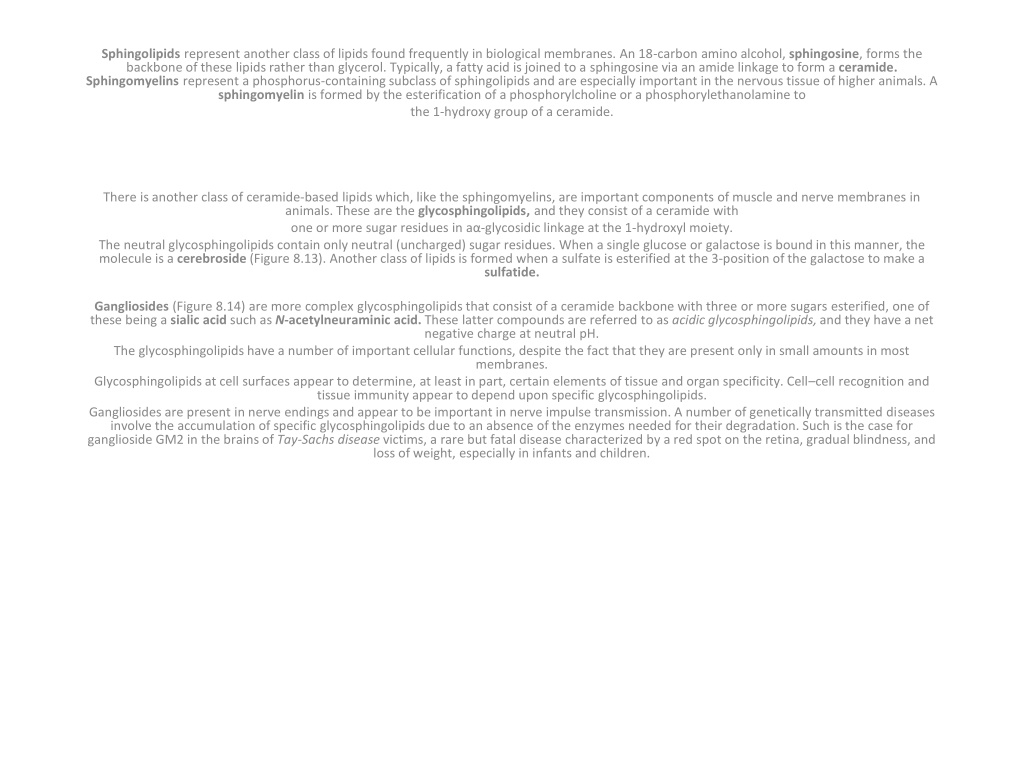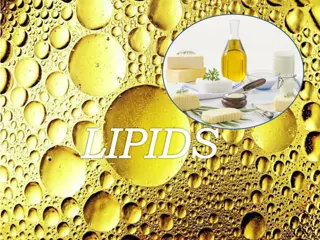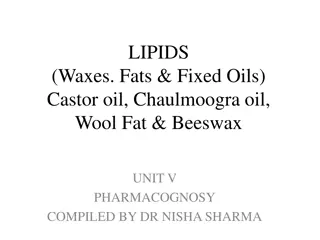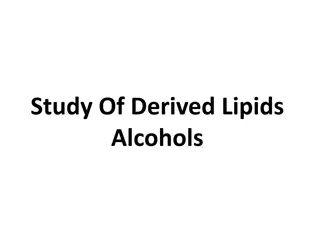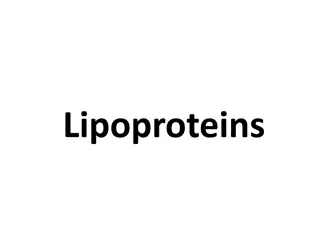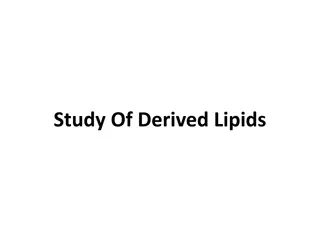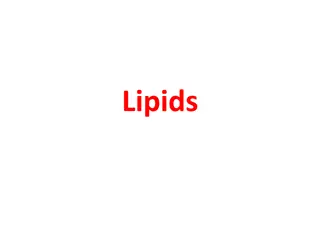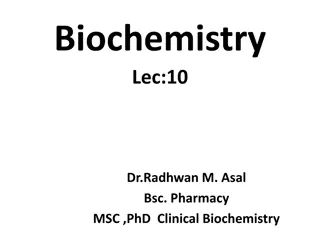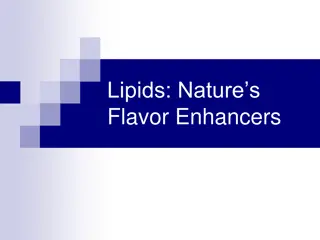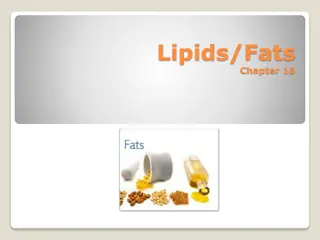Understanding Diverse Classes of Lipids in Biological Systems
Sphingolipids and waxes are important classes of lipids found in biological membranes, each with unique structures and functions. Sphingolipids, including sphingomyelins and glycosphingolipids, play crucial roles in nerve transmission, cell recognition, and tissue immunity. Waxes, on the other hand, provide water-repellent properties to skin, plants, and bird feathers. Additionally, terpenes, derived from isoprene units, encompass a variety of compounds like carotenoids and polyprenols with diverse biological functions.
Download Presentation

Please find below an Image/Link to download the presentation.
The content on the website is provided AS IS for your information and personal use only. It may not be sold, licensed, or shared on other websites without obtaining consent from the author. Download presentation by click this link. If you encounter any issues during the download, it is possible that the publisher has removed the file from their server.
E N D
Presentation Transcript
Sphingolipids represent another class of lipids found frequently in biological membranes. An 18-carbon amino alcohol, sphingosine, forms the backbone of these lipids rather than glycerol. Typically, a fatty acid is joined to a sphingosine via an amide linkage to form a ceramide. Sphingomyelins represent a phosphorus-containing subclass of sphingolipids and are especially important in the nervous tissue of higher animals. A sphingomyelin is formed by the esterification of a phosphorylcholine or a phosphorylethanolamine to the 1-hydroxy group of a ceramide. There is another class of ceramide-based lipids which, like the sphingomyelins, are important components of muscle and nerve membranes in animals. These are the glycosphingolipids, and they consist of a ceramide with one or more sugar residues in a -glycosidic linkage at the 1-hydroxyl moiety. The neutral glycosphingolipids contain only neutral (uncharged) sugar residues. When a single glucose or galactose is bound in this manner, the molecule is a cerebroside (Figure 8.13). Another class of lipids is formed when a sulfate is esterified at the 3-position of the galactose to make a sulfatide. Gangliosides (Figure 8.14) are more complex glycosphingolipids that consist of a ceramide backbone with three or more sugars esterified, one of these being a sialic acid such as N-acetylneuraminic acid. These latter compounds are referred to as acidic glycosphingolipids, and they have a net negative charge at neutral pH. The glycosphingolipids have a number of important cellular functions, despite the fact that they are present only in small amounts in most membranes. Glycosphingolipids at cell surfaces appear to determine, at least in part, certain elements of tissue and organ specificity. Cell cell recognition and tissue immunity appear to depend upon specific glycosphingolipids. Gangliosides are present in nerve endings and appear to be important in nerve impulse transmission. A number of genetically transmitted diseases involve the accumulation of specific glycosphingolipids due to an absence of the enzymes needed for their degradation. Such is the case for ganglioside GM2 in the brains of Tay-Sachs disease victims, a rare but fatal disease characterized by a red spot on the retina, gradual blindness, and loss of weight, especially in infants and children.
Waxes Waxes are esters of long-chain alcohols with long-chain fatty acids. The resulting molecule can be viewed (in analogy to the glycerolipids) as having a weakly polar head group (the ester moiety itself) and a long, nonpolar tail (the hydrocarbon chains). Fatty acids found in waxes are usually saturated. The alcohols found in waxes may be saturated or unsaturated and may include sterols, such as cholesterol (see later section). Waxes are water-insoluble due to the weakly polar nature of the ester group. As a result, this class of molecules confers water-repellant character to animal skin, to the leaves of certain plants, and to bird feathers. The glossy surface of a polished apple results from a wax coating. Lanolin, a component of wool wax, is used as a base for pharmaceutical and cosmetic products because it is rapidly assimilated by human skin. Terpenes The terpenes are a class of lipids formed from combinations of two or more molecules of 2-methyl-1,3-butadiene, better known as isoprene (a five-carbon unit that is abbreviated C5). A monoterpene (C10) consists of two isoprene units, a sesquiterpene (C15) consists of three isoprene units, a diterpene (C20) has four isoprene units, and so on. Isoprene units can be linked in terpenes to form straight chain or cyclic molecules, and the usual method of linking isoprene units is head to tail (Figure 8.16). Monoterpenes occur in all higher plants, while sesquiterpenes and diterpenes are less widely known. The triterpenes are C30 terpenes and include squalene and lanosterol, two of the precursors of cholesterol and other steroids (discussed later). Tetraterpenes (C40) are less common but include the carotenoids, a class of colorful photosynthetic pigments. -Carotene is the precursor of vitamin A, while lycopene, similar to - carotene but lacking the cyclopentene rings, is a pigment found in tomatoes. Long-chain polyisoprenoid molecules with a terminal alcohol moiety are called polyprenols. The dolichols, one class of polyprenols (Figure 8.18), consist of 16 to 22 isoprene units and, in the form of dolichyl phosphates, function to carry carbohydrate units in the biosynthesis of glycoproteins in animals. Polyprenyl groups serve to anchor certain proteins to biological membranes.
Steroids Cholesterol A large and important class of terpene-based lipids is the steroids. This molecular family, whose members effect an amazing array of cellular functions, is based on a common structural motif of three six- membered rings and one fivemembered ring all fused together. Cholesterol is the most common steroid in animals and the precursor for all other animal steroids. The numbering system for cholesterol applies to all such molecules. Many steroids contain methyl groups at positions 10 and 13 and an 8- to 10-carbon alkyl side chain at position 17. The polyprenyl nature of this compound is particularly evident in the side chain. Many steroids contain an oxygen at C-3, either a hydroxyl group in sterols or a carbonyl group in other steroids. Note also that the carbons at positions 10 and 13 and the alkyl group at position 17 are nearly always oriented on the same side of the steroid nucleus, the -orientation. Alkyl groups that extend from the other side of the steroid backbone are in an -orientation. Cholesterol is a principal component of animal cell plasma membranes, and much smaller amounts of cholesterol are found in the membranes of intracellular organelles. The relatively rigid fused ring system of cholesterol and the weakly polar alcohol group at the C-3 position have important consequences for the properties of plasma membranes. Cholesterol is also a component of lipoprotein complexes in the blood, and it is one of the constituents of plaques that form on arterial walls in atherosclerosis. Steroid Hormones Steroids derived from cholesterol in animals include five families of hormones (the androgens, estrogens, progestins, glucocorticoids and mineralocorticoids) and bile acids. Androgens such as testosterone and estrogens such as estradiol mediate the development of sexual characteristics and sexual function in animals. The progestins such as progesterone participate in control of the menstrual cycle and pregnancy. Glucocorticoids (cortisol, for example) participate in the control of carbohydrate, protein, and lipid metabolism, whereas the mineralocorticoids regulate salt (Na_, K_, and Cl_) balances in tissues. The bile acids (including cholic and deoxycholic acid) are detergent molecules secreted in bile from the gallbladder that assist in the absorption of dietary lipids in the intestine.
PROBLEMS 1. Draw the structures of (a) all the possible triacylglycerols that can be formed from glycerol with stearic and arachidonic acid, and (b) all the phosphatidylserine isomers that can be formed from palmitic and linolenic acids. 2. Describe in your own words the structural features of a. a ceramide, and how it differs from a cerebroside. b. a phosphatidylethanolamine, and how it differs from a phosphatidylcholine. c. an ether glycerophospholipid, and how it differs from a plasmalogen. d. a ganglioside, and how it differs from a cerebroside. e. testosterone, and how it differs from estradiol. 3. From your memory of the structures, name a. the glycerophospholipids that carry a net positive charge. b. the glycerophospholipids that carry a net negative charge. c. the glycerophospholipids that have zero net charge. 4. Compare and contrast two individuals, one of whose diet consistslargely of meats containing high levels of cholesterol, and the otherof whose diet is rich in plant sterols. Are their risks of cardiovasculardisease likely to be similar or different? Explain your reasoning.
